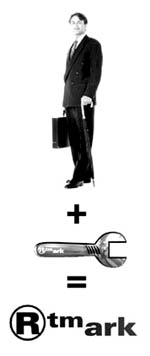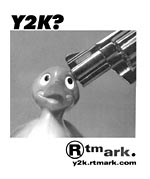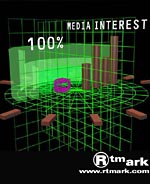| Spanner Ads
by Iain Aitch 6/28/00 ®TMark were recently included in New York's Whitney Biennial - one of the artworld's most prestigious exhibitions - even though they have never considered themselves artists. Obviously, as writer Iain Aitch found, being web terrorists, they bit the hand that fed them… |
 |
Web-based US collective
®TMark (pronounced art-mark) are far from
traditional artists. Rather than an exhibition space for their work, their
website acts as a clearing house for making trouble. They bring
pranksters, activists and art-terrorists together with those who have some
money to spare and a political axe to grind, a twisted sense of humour, or
simply an employer they dislike. Investors in ®TMark put up the money and 'workers' receive the
payment for carrying out an action, which can be anything from subverting
a piece of computer software to undermining a US Presidential election
campaign.
For ®TMark the mass-media is their gallery. Their website contains seemingly endless hyperlinks to news reports about their actions, and payment for a prank is often dependent upon it being reported in the press. 'We like it most when a project goes well, and it gets a big splash too', says Guerrero. 'This maximises impact in several areas - public profile as well as basic effectiveness. It fulfils both pedagogical and practical goals.' The main point of widespread media exposure is to cause maximum embarrassment for the businesses targeted. One such example being the project which hit Panasonic Interactive Media's 'Secret Writer's Society' educational software package. Here a bug was inserted into the program causing children's PCs to blurt out the profane contents of a filter which was meant to stop the speak-and-learn software from repeating swear words that mischievous children may key in. The rogue programmer was paid $1000 for his trouble and news desks had an amusing 'and finally' story. Nice business.
Instead of gleefully accepting the plaudit, ®TMark did it their way, altering the set up on the Whitney PCs so that anyone attempting to visit the ®TMark site was re-directed to other sites hosted on ®TMark's server. These sites ranged from a Backstreet Boys fan site to pornography. The group put out an invitation via its website inviting all comers to become a Whitney exhibited artist and the glut of applicants who uploaded a site to the ®TMark space had their work on show as part of a rolling on-line exhibition. To add insult to injury ®TMark auctioned off its invites to the opening bash on electronic auction site, ebay, raising $8,000 in the process.
'Otherwise we would have got nothing for doing the Whitney Biennial. From the way we were treated we would have never known it was such a great thing. We were not offered a penny. So what could we do? We had to parlay the cachet into some cash somehow, or the opportunity would have been worthless for us. In theory, gallery artists turn the prestige into dollars by selling their work. We have nothing to sell, at least in that sense, so without some special manoeuvres we were screwed.' The slight upset that curators at the Whitney may have experienced is nothing compared to that felt by some of the victims of ®TMark's creative enterprise. Republican US presidential candidate George Bush Jr must have been kicking himself, not to mention members of his staff responsible for the georgewbush.com website, when a site parodying it went up at gwbush.com. Bush's staff had systematically been buying up all the domain names that could perceivably be used to attack their candidate in the run-up to the presidential elections, such as bushsux.org and bushblows.com but had not snapped up this one glaringly obvious choice.
®TMark started out in 1993 by channelling $5000 to fund an action which emasculated talking GI Joe dolls by switching their voice boxes with that of a Barbie. Some 300 dolls were altered and smuggled back into toy shops, leaving children who expected a gruff-voiced army man with one who said 'I love shopping' or 'let's make plans for the weekend'. Their projects can often attract the unwelcome attention of corporate lawyers, though with one project, a CD entitled Deconstructing Beck, this seems to have been the aim of the project from the outset. The CD, which was put together by an organisation calling itself Illegal Art, was made entirely of samples from the works of Geffen Records' recording artist Beck, who himself is well known for his use of sampled music in his recordings. The release soon found it's way to the desk of Geffen's lawyers who fired off the standard 'cease and desist' letter. This immediately allowed the Illegal Art and ®TMark publicity machines to start work on a media campaign stating that Beck was trying to silence their CD. World-wide coverage of the project was guaranteed. Another example of spin-doctoring for subversion well done. ®TMark also recently aided fellow electronic artists, etoy, in their tussle with toy retailer eToys, who had managed to get a US court injunction against the etoy.com domain which the company had found a little too similar to its etoys.com address - even though the artists had registered theirs first. In the resulting war of words etoy came out on top with the resulting bad publicity causing eToys' share value to plummet. The toy sellers beat a hasty and expensive retreat, having been ordered to foot the bill for etoy's legal costs.
®TMark have also funded anti-art establishment actions by the London-based Molotov Organisation, whose outings have included an exhibition of fruit and vegetable animals in the toilets of the Institute of Contemporary Art as well as a spoof lecture at Tate Britain. Here, tourists and art-lovers were told bare-faced lies about various works, including the 'fact' that Matisse's The Snail was created merely as a device to enable the ageing artist to look up the skirts of female art students as they climbed a ladder to assemble it under his instruction. The ®TMark website can be found at http://rtmark.com/ ®TMark appeared in the 'Tech_nicks' exhibition at The Lux Gallery, London from 10-25 June. The exhibition tours the UK to the Site Gallery, Sheffield (27 June - 2 July), Hull Time Based Arts (8 July to 16 July) and PVA, Bridport (24 July to 30 July). For more details visit http://www.noaltgirls.org/tech_nicks Iain Aitch is a London-based writer. |
back to insight






